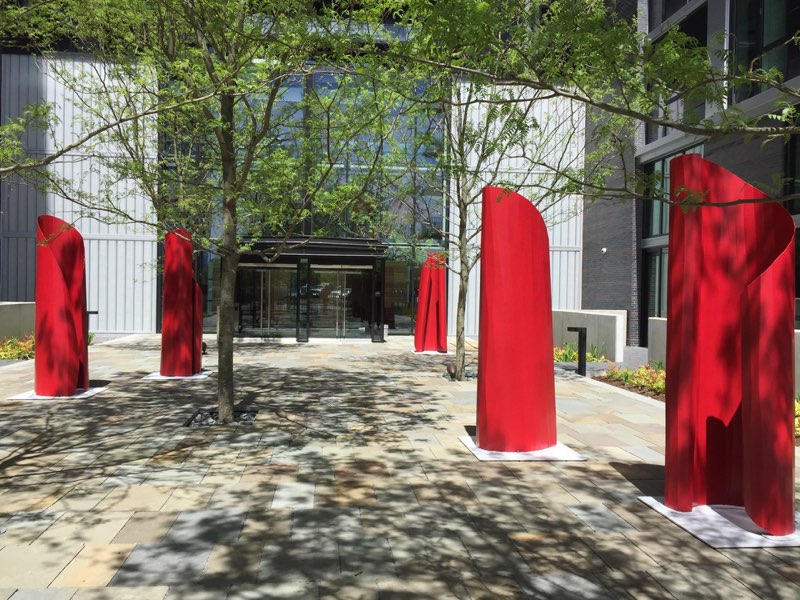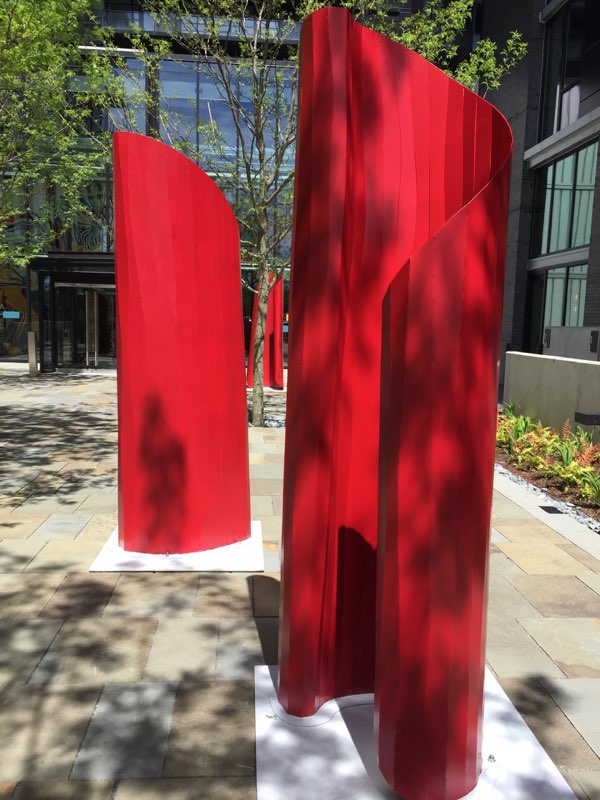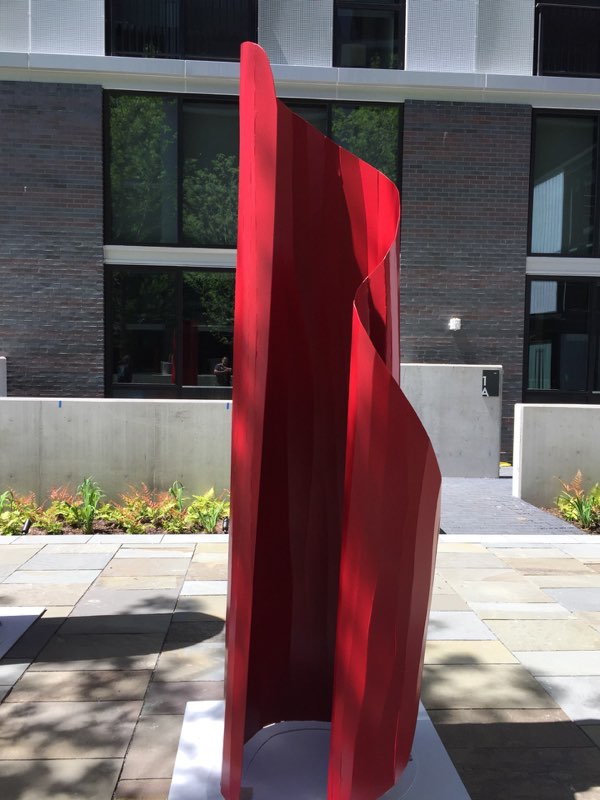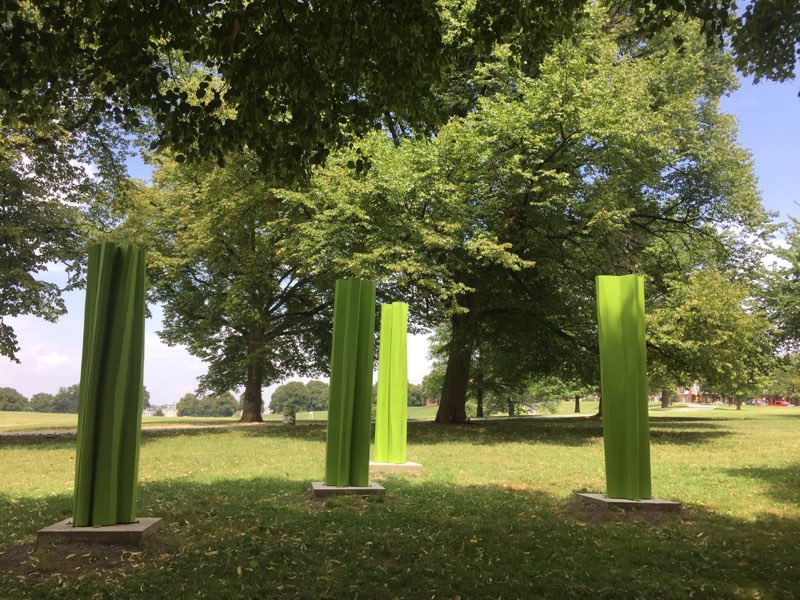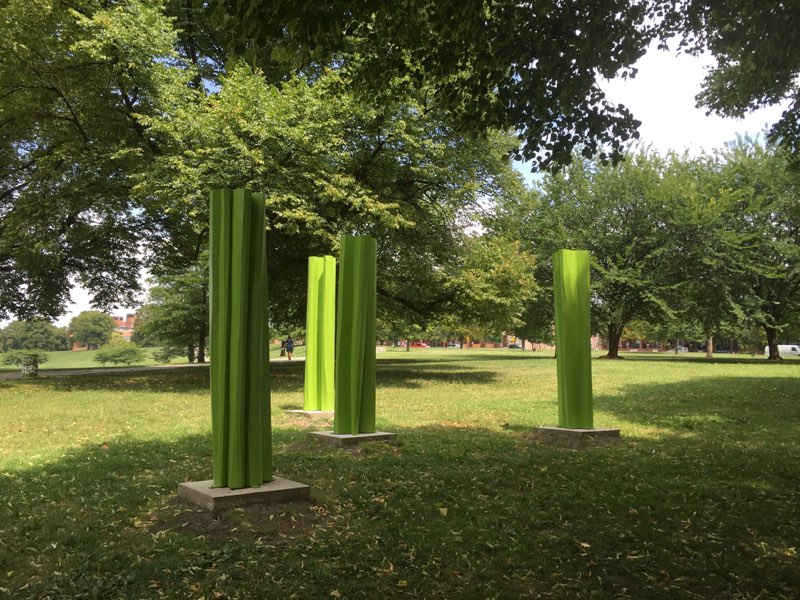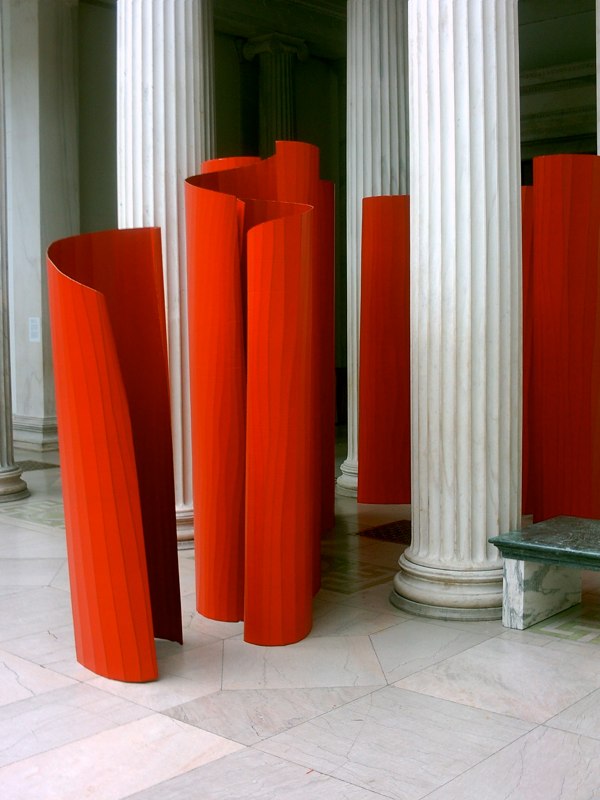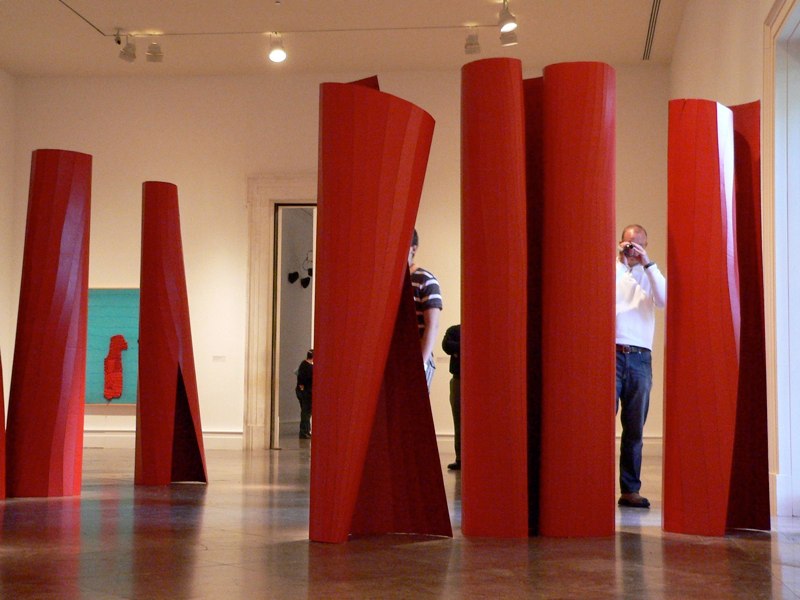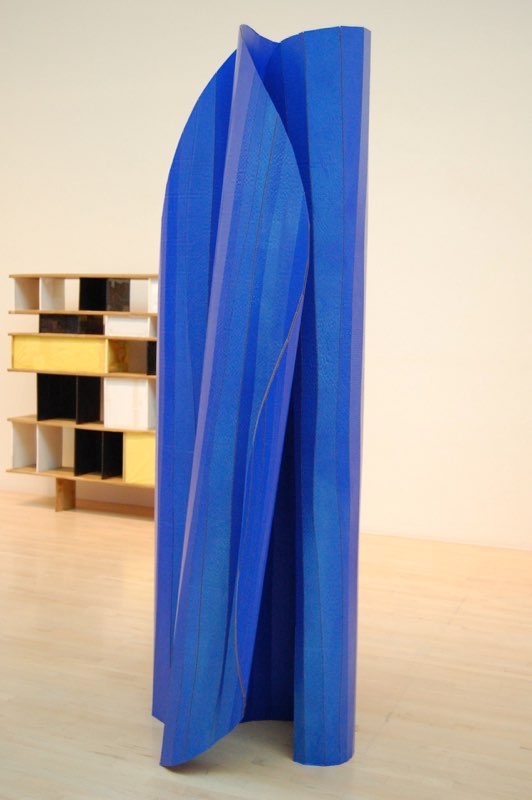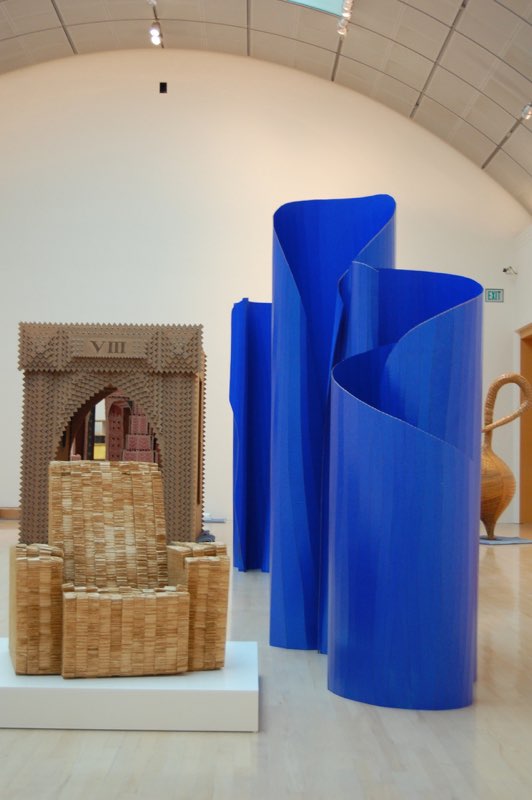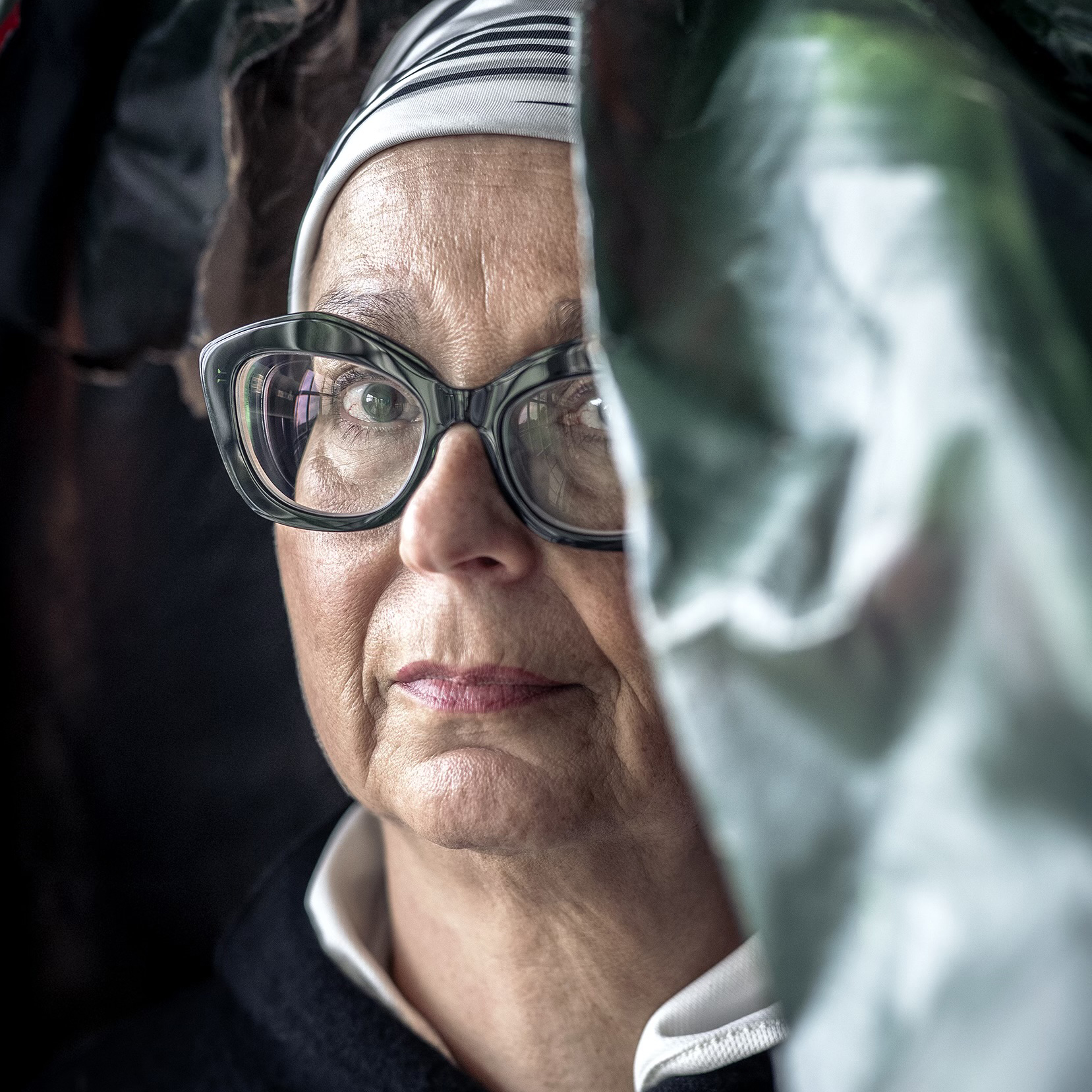Sculptures & Installations
Minimalism on a Human Scale
I transform cardboard, a mundane material, into pliable and movable sculptures through paint and structural cuts. Within a group setting, I connect more or less open segments loosely with each other. They interlock, touch each other, and form openings through which a viewer can obtain new perspectives of the sculptural setting.
The material used is visibly vulnerable in its imperfection and notably unpretentious. Scale, color, and surface reflection create a strong presence in their environment. Using a “natural” handmade process, I reduce the product to a minimal language in color and form, forming a delicate body language of individual pieces. Single segments create safe, warm realms and remind us of our nature, thus simultaneously inclusive, exclusive, and interactive.
I reclaim liminal spaces and defining them as specific places by elementary notions of color, form, and placement. The settings communicate emotionally warm and approachable sites. Through their gaps and openings, visitors are welcome to walk in and around while experiencing the place as changeable, dynamic, and harbor at the same time. With their vertical constructions, round shapes, and vivid, natural forms, they unify architecture with vital elements and artistic expression while staying true to interaction on a human scale.
For public art projects, modular sculptures are conveyed in steel.
Concept
Through my sculptures and installations, I explore how human beings live in spheres, whether contained or imagined. Retreat and introspection stay in a balance between curiosity and exploration. Housing, home, and life are strongly related to our nature and the need to feel safe, protected, harbored, and welcome while staying open, curious, and explorative about the outside world.
I create an energizing relationship between installation, architecture, and site. Various dynamic relationships form through sculptural groupings and gaps, inviting visitors to interact while walking through surprise openings in a constant flow of ever-changing perspectives. This connection creates a unique experience for visitors while suggesting a warm climate of living, coexistence, and interactions that occupy common spaces, provoking a dialog about space as a field of possible action.
This connection creates a unique experience of respite and fluctuation, understanding a place as changeable, dynamic, and harboring simultaneously. At first, the artwork is siteless, systemic, and unfinished. Still, once the pieces submerge into the proposed environment, they function as a spatial activator, amplify the surrounding scenery, and create fields of possible action. The sculptural setting allows for recreation, gathering, and play promoted through the openings and gaps of the installation.
Mantles
Mantles
Five modular sculptures
Outdoor UV paint on steel, 90 inches high, 40 inches diameter
Resident Courtyard at the Navy Pier Waterfront, Washington DC
2019
In collaboration with Kyle Miller &Tim Scofield
The playful and colorful concept offers a site where residents can explore and interact with the outdoor space. The vitality of the set of five modular sculptures translated from cardboard into steel structures organically circulates throughout the courtyard. Mantles, reflecting on coats or coverings of all sorts, act as sculptural modular elements that offer spaces for play, rest, and respite. Mantles are an integrative installation for a residential multi-use space for lounging and entertainment options. The ground level provides a natural feeling for all residents that include recreation, gatherings, and activities. A flowing design, sculpturally succinct, and Bauhaus-oriented design features, integrate into a contemporary concept.
Mantles expand into the larger environment of a built community while staying true to arts and the gilded field of design. The installation site offers generous openings and easy passages. Connecting people with the building activates the space and engages the public as connectors, dividers, or privacy screens. In their vertical appearance, Mantles offer ‘fabric’ folds for socialization and lingering in numerous nooks, where residents can sit, stand, lean on or play. This connection creates a unique experience for visitors while suggesting a warm climate of living, coexistence, and interactions that occupies common spaces, provoking a dialog about space as a field of possible action.
The concept seeks to create a unique experience of respite and fluctuation, understanding place as changeable, dynamic, and harbor simultaneously. The setting functions as a spatial activator and amplifies the surrounding scenery, creating a possible action field. The site-specific installation allows for recreation, gathering, and play through the structure’s openings and implicated spheres of activities.
Stems
Stems
Steel, Acrylic paint, 90 inches high, various diameter
Patterson Park, Baltimore MD
2015
In collaboration with Kyle Miller &Tim Scofield
The neighborhood of Patterson Park in Baltimore is a wonderful multi-cultural community that enjoys its park every day. My modular sculptures titled Stems intends to enhance visitors’ experience while also engaging the local community. The relationship between installation and site can be a unique and energizing experience that connects visitors while also considering more significant issues such as how we as humans integrate into and impact our surroundings. My work creates interactive environments and speaks to the relation of the visitor to place and space.
I have been awarded for that public art project in Patterson Park that addresses a broad audience and local neighborhood while seeking recovery, a natural environment, and a balanced lifestyle for urban dwellers. In this context, I display Stems, copied and recreated trees destroyed by environmental disasters, transforming cardboard into weather-resistant metal works.
Stems are arranged in an organic pattern that allows visitors to walk through and feeling welcomed. Initially, they are based on recreating giant trees destroyed by environmental disasters or ecological diseases. I preserve and copy shapes of found stumps, reviving bygone trees through an interactive installation.
Inspired by nature, I create spheres encouraging visitors to wander through the installation contemplating memories of what we have lost in nature.
Walls of Love
Walls of Love
45 modular sculptures, various sizes, installation, acrylic on corrugated cardboard
Albright-Knox Art Gallery, Buffalo NY
Beyond Western New York – Biennale
2007
One may think Artemis Herber’s works are created with steel or wood, but closer inspection reveals that they are actually made of cardboard. Herber is drawn to this unpretentious, everyday material because of its sturdy yet imperfect, vulnerable nature, and she is fascinated by its ability to incite mystery and excitement in the form of the box. Often after the contents of a box are revealed, the box is collapsed, discarded, and forgotten. By mastering the art of “scoring,” Herber has cleverly devised a way to manipulate her corrugated muse to fold, bend, or sway in any direction she desires. Through this process, cardboard is transformed and takes on a delicate body language. When coupled with her sumptuous color palette, this unique exploration of an unlikely material creates poignant, minimal works that meld painting with sculpture.
Wall of Love, a site-specific installation for the Albright-Knox Art Gallery, is not contained to one space. Instead, its ardent, red formations undulate in and out of various galleries, creating a discourse not only with visitors but also with other artworks as well.
Amassed from single segments of intentionally curled cardboard she calls “wraps,” the work is meant to envelop the viewer and establishes a balance between “stability and movement, equality and individuality, welcoming and rek]jecting attitudes, embracing and defending moments.”
While it is natural to associate walls with various borders and boundaries, both physical and mental, which may awaken potentially negative sentiments, this installation is meant to evoke a positive, warm, and embracing climate that, according to Herber, reflects a kind side of humanity.
Holly E. Hughes, Associate Curator
Coats
Modular sculptures, various sizes, installation, acrylic on corrugated cardboard
This End Up: The Art of Cardboard
San Jose Museum of Art CA
2008
Curated by Jodi Throckmorton
The artists in this exhibition challenge the limits of cardboard by investigating topics ranging from formal concerns to social commentary and engineering. As a relatively cheap material, cardboard allows artists to work on a large scale that might not be otherwise possible. This exhibition revealed ways that artists challenge the limits of cardboard by investigating topics ranging from formal concerns to social commentary and engineering. Artists include Joan Brown, Shannon Goff, Frank O. Gehry, Robert Rauschenberg, and others.
Coats function as protective mantles covering our bodies, defending against elements, separating interior and environment. The Coats body of work reflects the correlative relationship between inner and outer worlds, place and space. Individual segments are sheltering womb-like spheres. They create a warm climate of interaction in various groupings, floating dynamically, with boundaries constantly redefined.
